
The Noctuidae, commonly known as owlet moths, cutworms or armyworms, are the most controversial family in the superfamily Noctuoidea because many of the clades are constantly changing, along with the other families of the Noctuoidea. It was considered the largest family in Lepidoptera for a long time, but after regrouping Lymantriinae, Catocalinae and Calpinae within the family Erebidae, the latter holds this title now. Currently, Noctuidae is the second largest family in Noctuoidea, with about 1,089 genera and 11,772 species. However, this classification is still contingent, as more changes continue to appear between Noctuidae and Erebidae.

Panthea coenobita is a species of moth of the family Noctuidae. It is found in North Europe, East Europe and Southern Europe, the central and northern European part of Russia, Japan, Korea, northern China, the Russian Far East, southern and western Siberia and Turkey.
Afotella is a monotypic moth genus of the family Noctuidae erected by William Barnes and Foster Hendrickson Benjamin in 1926. Its only species, Afotella cylindrica, was first described by Augustus Radcliffe Grote in 1880. It is found in western North America from Saskatchewan and Alberta south to California.
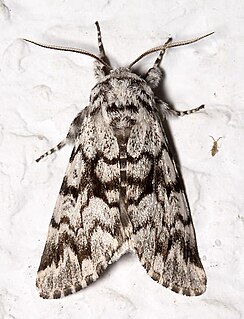
Panthea acronyctoides, the black zigzag or tufted spruce caterpillar, is a moth of the family Noctuidae. The species was first described by Francis Walker in 1861. It is found in North America from Newfoundland to British Columbia and adjacent northern states, south in the west to Colorado, south in the east to New England and Kentucky.
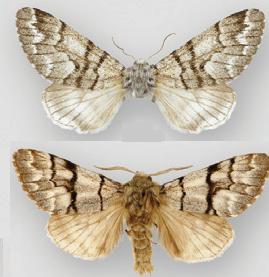
Panthea furcilla is a species of moth of the family Noctuidae. It is found across the boreal forest region of Canada west to the Rocky Mountains, and in the eastern parts of the United States, from Maine to Florida, west to Texas, north to Indiana and Ohio.

Euxoa tronellus is a moth of the family Noctuidae first described by Smith in 1903. It is found in western North America from western North Dakota and South Dakota, west across southern Saskatchewan and southeastern Alberta to Washington, south to southern California and northern New Mexico.

Abagrotis mirabilis is a moth of the family Noctuidae first described by Augustus Radcliffe Grote in 1879. It is found in western North America, from British Columbia south to California.
Abagrotis nanalis is a moth of the family Noctuidae first described by Augustus Radcliffe Grote in 1881. It is found in North America from southern British Columbia east to southwest Saskatchewan and western North Dakota, south to northern New Mexico and California.
Abagrotis nefascia is a moth of the family Noctuidae first described by Smith in 1908. It is found in North America from Alberta and British Columbia down through Massachusetts to California. The species is listed as threatened in the US state of Connecticut.
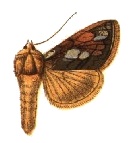
Plusia putnami, the Lempke's gold spot or Putnam's looper moth, is a species of moth of the family Noctuidae. It is found in the Palearctic realm, from Japan and eastern Siberia to Fennoscandia, Great Britain, and France. In North America, it ranges from Newfoundland and Labrador to central Alaska and the interior of British Columbia, south to Pennsylvania, Washington, north-eastern California, and in the Rocky Mountains to Utah and Colorado.

Panthea gigantea is a moth of the family Noctuidae. It is found throughout much of the warmer and drier regions of western North America from south-central British Columbia, south to the state of Durango in Mexico and from the Black Hills of South Dakota, western Nebraska and the Texas Panhandle west to Washington, Oregon and the coast of California.

Panthea is a genus of the owlet moth family, Noctuidae. The word Panthea is from Greek, meaning "of all gods".

Panthea apanthea is a moth of the family Noctuidae. The species is found in three areas of the south-western United States, Coconino County and Apache County in Arizona, and El Paso County in east-central Colorado.

Panthea judyae is a moth of the family Noctuidae. It has been collected in the Mogollon Mountains and Big Burro Mountains of south-western New Mexico, the Huachuca Mountains of south-eastern Arizona, and the Sierra Madre Occidental of northern Mexico, at elevations of 1800–2400 m.

Copablepharon grandis, the pale yellow dune moth, is a moth of the family Noctuidae. The species was first described by Strecker in 1878. It is found in North America from southern Alberta east to south-western Manitoba, the eastern parts of South Dakota, North Dakota and Iowa, west to California and south to southern Arizona, New Mexico and western Texas.

Euxoa citricolor is a moth of the family Noctuidae first described by Augustus Radcliffe Grote in 1880. It is found in North America from eastern South Dakota and western North Dakota, northwest to southern Alberta, west to western Washington and south and east to southern California, New Mexico and Colorado.

Euxoa comosa, the hairy euxoa moth, is a moth of the family Noctuidae first described by Herbert Knowles Morrison in 1876. It is found in western North America, except the Pacific coast, ranging east through the northern Great Plains, and in the Hudsonian zone to the Atlantic Ocean. It is found in every province and territory of Canada, except Nunavut.
Diarsia calgary, the Calgary dart, is a moth of the family Noctuidae. The species was first described by Smith in 1898. It is found in North America in the mountains and foothills from Yukon, south to Arizona and New Mexico, west to the coast of British Columbia. There is a disjunct population in central western California.
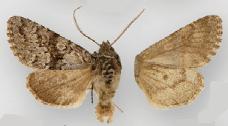
Lasionycta subfuscula is a moth of the family Noctuidae. It is found from south-western British Columbia and south-western Alberta south to southern Oregon in the west and to southern Colorado and Utah in the Rocky Mountains.
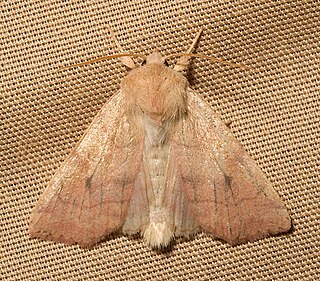
The lesser eyed sallow is a moth of the family Noctuidae. It is found from Alaska and New Brunswick to Ontario, south to Connecticut in eastern North America. In western North America it is found from Saskatchewan and Alberta, south to Utah and California.












